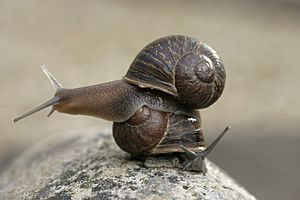Jeremy (snail) facts for kids

Jeremy the left-coiling snail on top of a right-coiling snail, Bree.
|
|
| Species | Cornu aspersum |
|---|---|
| Breed | Sinistral |
| Sex | Hermaphrodite |
| Hatched | London, UK |
| Died | 11 October 2017 |
| Owner | University of Nottingham |
| Residence | United Kingdom |
| Offspring | 56 |
| Appearance | Left-coiled |
| Named after | Jeremy Corbyn |
Jeremy was a special garden snail studied by scientists. He died on October 11, 2017, when he was at least two years old. Jeremy was unique because his shell coiled to the left. Most snails have shells that coil to the right.
This left-coiling was caused by a very rare genetic mutation. It is thought to happen only once in a million snails. Jeremy was named after Jeremy Corbyn, a British politician. He was called "lefty" because of his shell, and because Corbyn liked gardening. Jeremy became famous around the world after scientists asked for help finding other left-coiled snails for him to mate with.
Scientists at the University of Nottingham studied Jeremy. They hoped to learn about genes from him and his babies. This research could help them understand how genes affect body parts in humans and other animals.
Jeremy is featured in a documentary called Jeremy the Lefty Snail and Other Asymmetrical Animals. Also, in 2018, the podcast This is Love made an episode about him called "One in a Million."
Jeremy's Life and Reproduction
A retired scientist found Jeremy in southwest London. He sent the snail to the University of Nottingham. A team of researchers, led by Dr. Angus Davison, started looking for another "lefty" snail.
Left-coiled snails have their reproductive parts in a different position. This means they can only mate with other left-coiled snails. Two other left-coiled snails were found and sent to the university. However, these two snails mated with each other first. They had 170 babies, all with normal right-coiling shells.
Later, one of these left-coiled snails mated with Jeremy. They had 56 babies. All of Jeremy's babies also had normal right-coiling shells.
Scientists believe that the left-coiling trait might show up again in a future generation. This is because it's caused by a recessive gene. This means the trait can skip a generation and reappear later. In snails, the shell's coiling direction is often decided by the mother's genes. Jeremy's mother likely had a normal shell but carried the recessive gene. Jeremy inherited this gene, causing his left-coiled shell. Even though Jeremy's babies have normal shells, they might carry the recessive gene. This means their own babies could be left-coiled.
Further Research and Discoveries
While studying Jeremy, Dr. Davison found a gene that controls shell coiling. This gene decides if a snail's shell coils left or right. He thinks this same gene might affect how body parts are placed in humans and other animals. This research could help us understand how our organs are positioned in our bodies.
Dr. Davison said that even though Jeremy had died, his babies were important. He hoped to learn why left-coiled snails are so rare. He also wanted to understand how the left and right sides of a body are formed at a tiny, molecular level. He wondered if a similar process happens when human bodies develop.
Scientists continued to study Jeremy's offspring. By October 2017, the University of Nottingham had seven left-coiled snails.
In July 2018, the research team announced a new "lefty" snail named St Stephen. This snail was from a different species called Cepaea nemoralis. The team tweeted that they were looking for mates for St Stephen too.
This research could help us understand rare conditions in humans. These conditions include Situs inversus and Situs ambiguus. In these conditions, a person's organs are reversed or in the wrong place because of genetic changes.
Sinistral Snails
Jeremy was a very rare example of a sinistral snail. "Sinistral" means left-coiled. Most snails of his species have right-coiling shells. However, in some other snail species, left-coiling shells are quite common. In a few cases, left-coiling is even the normal direction for that type of snail.
See also
 In Spanish: Jeremy (caracol) para niños
In Spanish: Jeremy (caracol) para niños

